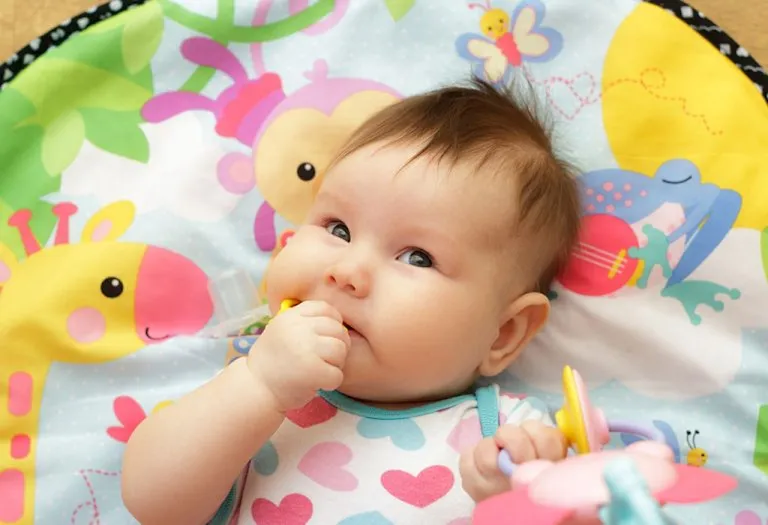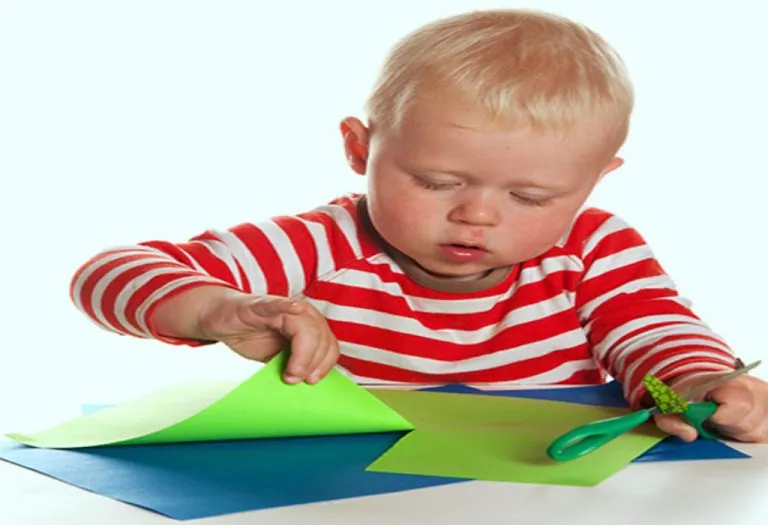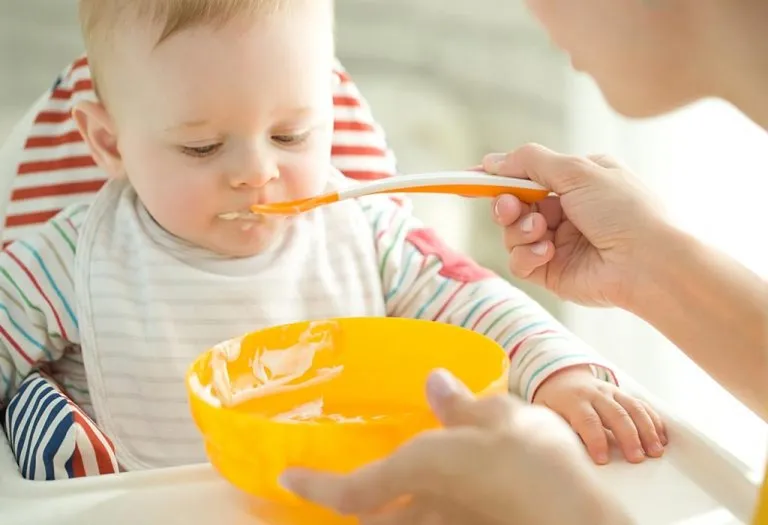Baby’s Body Language – Diffferent Ways to Decode It
- What Is the Significance of Responding to Baby Cues?
- Understanding Your Baby’s Different Body Language Cues
- FAQs
From the very first cry, your baby starts to communicate with you. For the first few days, she will only cry to let people know that she is hungry, sleepy, uncomfortable, anxious etc. As she grows, she starts communicating through body language. But, as a parent how do you understand what your baby is trying to tell? In this article, we’ll discuss how to decode baby’s body language?
What Is the Significance of Responding to Baby Cues?
Responding to baby cues is essential for fostering healthy development and building strong parent-child relationships. Understanding and meeting a baby’s needs communicates safety, security, and trust, laying the foundation for emotional well-being.
1. Establishing Trust and Security
Responding promptly and sensitively to a baby’s cues helps them feel secure and builds trust in their caregivers. This sense of security forms the basis for healthy attachment and emotional development.
2. Meeting Basic Needs
Babies communicate their needs through cues like crying, gestures, and facial expressions. Responding to these cues ensures that their basic needs for food, comfort, and safety are met promptly, promoting physical health and overall well-being (1).
3. Enhancing Communication and Bonding
Engaging with a baby’s cues encourages communication and bonding between parents and infants. By responding attentively, caregivers validate the baby’s experiences and emotions, strengthening the parent-child relationship.
4. Supporting Emotional Regulation
Responsiveness to baby cues plays a crucial role in teaching infants to regulate their emotions. When caregivers consistently meet their needs, babies learn to trust their environment and develop self-soothing strategies, laying the groundwork for healthy emotional regulation later in life.
Understanding Your Baby’s Different Body Language Cues
As a new parent, understanding a newborn’s body language is difficult. However, it is important for every parent to be able to read the baby’s body language. When your baby is a few months old, understanding infant body language isn’t that difficult. Listed below is a quick guide to the body language cues of a baby.
1. Kicking Legs in the Air
This is one of the first signs that your baby is trying to communicate with you.
What Does It Mean
If you see your baby doing so, then it means that she is very excited and happy. The excitement could be on seeing you or something that fascinates her like water, her favourite toy or even her food bowl (if she is hungry).
How to Respond
Kicking in the air will help your baby to develop the muscles that will help her in crawling. Therefore, encourage her to kick her legs in the air by getting the things that excite her.
2. Turning her Face Away
You may be feeding her or trying to talk to her, but she just wouldn’t look at you. Do you suppose your baby is ignoring you or is angry with you?
What Does It Mean
This could mean two things. First, she may just try to process what is happening or what is going on in her surroundings or she could be angry with you for intruding into her personal space.
How to Respond
Just let her be, for a while. Allow her to explore. Probably she has seen a lizard on the wall and is curious to know what it is or is simply amazed to see a reflection of herself in the mirror. Once she has satiated her curiosity, she will get back to you.

3. Arching Her Back
Some babies may arch their backs while being fed or while being held. According to the Birth Injury Help Center, There can be many reasons for a baby to do so (2).
What Does It Mean
If a baby does so in the middle of a feed, it may mean that she does not want to be fed any longer. It could also mean that the baby has colic or suffers from digestive disorders like GERD or acid reflux. Another very common reason for arching their backs by older infants is when they are frustrated, angry or tired.
At times, babies suffering from Autism, Rumination disorder or Kernicterus are also seen arching their backs.
How to Respond
Just try to calm her down. You can divert her attention by taking her outside and showing her things which she would be interested in. You can even pat her back slowly or rock her so that in case she is sleepy. If the crying persists, consult a Paediatrician immediately.
4. Stretching Out Arms
Babies with outstretched arms with open hands and fingers are a good sign.
What Does It Mean
It means that your little munchkin is happy and in a good mood. However, it can also be that the baby has newly acquired the skill of sitting and is trying to balance herself while trying to sit up straight.
How to Respond
Both of you should enjoy the moment. Take her to a park or for a walk. You can also go about your rare shopping sprees on these days when she is in a good mood. She will enjoy absorbing the new things that she comes across, and you will get some time for retail therapy.
In case, the outstretched arms are to balance herself while trying to sit, give her a hand. Otherwise, you can surround her with a lot of soft pillows and cushions so that even if she loses balance, she may not hurt herself.

5. Fist Clenching
The baby may be seen doing this with or without crying.
What Does It Mean
Clenching of the fist is a sign that the baby is extremely stressed out due to hunger (3).
How to Respond
In case you see your baby doing so (even if he is not crying), your obvious response should be to feed your baby immediately.
6. Baby Folding Her Knees
Babies sometimes can be seen folding both their knees and bringing them towards their stomach.
What Does It Mean
The sign of a baby folding her knees towards her stomach means that she has some kind of digestive problems like constipation, gas or stomach uneasiness.
How to Respond
Try to ease her up by helping her to burp by slowly and gently patting her back. In case you are nursing her, avoid oily and spicy food which may cause her gas, acid reflux, constipation or gas. If the sign persists, consult a paediatrician.

7. Grabbing Ears
It is usually done by babies when they are trying to explore their body parts, but it could mean something else too.
What Does This Mean
According to the National Institute on Deafness and Communication Disorders, apart from exploring her ears, it can be a sign of pain and discomfort due to an ear infection. It is also seen that babies during teething do this (4).
How to Respond
If in case they are not teething, you can take your little one to a Paediatric ENT specialist for a thorough check-up.
8. Rubbing of Eyes
Rubbing of eyes may often be followed by a big yawn and sometimes even crying.
What Does It Mean
It simply means that she is tired and wants to sleep.
How to Respond
Just rock her for some time or pat her slowly, and she will quickly doze off. If she is crying, you can start by singing to her to calm her down first. In case she is not sleepy, you can check if she has acquired an eye infection and also consult a paediatrician.

9. Banging Her Head
Headbanging is common among babies and is nothing to worry about. It is more common among male babies than female ones.
What Does It Mean
It may look scary, and parents may get disturbed seeing their baby banging his head, but it is nothing more than a technique that babies use to comfort or self-stimulate themselves according to the Sleep Foundation. (5). At times, it could mean that the baby is in pain.
How to Respond
If your baby has a habit of banging his head, make sure that he is not near a wall. If he bangs his head against the railings of his crib, get the railings padded or cushioned. You can also divert his attention by reading a story to him, singing something to him or playing with him. You can consult a Paediatrician to ascertain that he is not in pain.
10. Startling
A baby getting startled while being fast asleep is a common thing. It is nothing to be worried about. According to Stanford Medicine, it is a reflex which is quite common among babies before they are 5-6 months old (6).
What Does It Mean
This can mean that she got startled by some loud noise or something which disturbed her sleep.
How to Respond
Try to block all the outside noise. Making your baby sleep with some noise in the room like keeping the television or radio’s volume normal or talking over the phone may get her used to it.

11. Kicking and Breathing Quickly
Just as we adults want to do something when excited, babies kick and breathe fast when they are too excited (7).
What Does It Mean
It simply means that she is happy and excited about something. It can be due to something or someone that she has seen or a result of being able to do something that she wants to do.
How to Respond
On seeing your baby excited, “baby talk” with her. Play with her and respond to her back with equal enthusiasm.
12. Sucking Fingers
Finger or fist sucking by a baby may often be interpreted as the baby is hungry, but it may not always be so.
What Does It Mean
If your baby’s not hungry, it could also mean that your baby is trying to soothe herself in order before dozing off.
How to Respond
Firstly check if it is time for her feed. In case, it isn’t then you can just sing to her and give her a gentle pat to put her to sleep.

13. Grumpiness
Babies, despite their generally cheerful demeanor, can exhibit signs of grumpiness, often communicated through subtle cues that indicate discomfort or overstimulation.
What Does It Mean
If your baby appears unsettled and grumpy following a family gathering or activity, it may indicate overstimulation, signaling that they are overwhelmed and in need of quiet time.
How to Respond
Take your baby to a quiet environment and gently rock them until they calm down. Minimize social contact until they are settled. Playing soothing music or taking a leisurely walk can also help them relax and decompress.
14. Baby Hiccups
Baby hiccups present as repetitive, involuntary contractions of the diaphragm and vocal cords, resulting in a characteristic “hic” sound.
What Does It Mean
Hiccups are common in babies during their first year and often occur due to overfeeding or feeding too quickly (8).
How to Respond
Hiccups typically resolve within five to ten minutes. To alleviate them, consider changing breastfeeding positions or adjusting the baby’s solid food. Ensure proper burping after each feeding session and address any breastfeeding latch issues.
FAQs
1. Why is it important to decode a baby’s body language?
Decoding a baby’s body language enables caregivers to respond promptly and appropriately to their needs, promoting emotional security, bonding, and overall well-being. Understanding these cues also helps in building a strong parent-child relationship from an early age.
2. What are some common cues to look for in babies?
Babies communicate their needs and emotions through various cues, including facial expressions, body movements, vocalizations, and gestures. Common cues include smiling, crying, eye contact, reaching, and turning away. Recognizing and responding to these cues allows caregivers to address the baby’s needs effectively.
3. How can caregivers differentiate between different types of cries?
Babies use crying as a primary means of communication, but not all cries indicate the same need. Caregivers can learn to differentiate between hunger cries, discomfort cries, tiredness cries, and other types of cries based on their duration, intensity, and accompanying cues. By understanding these distinctions, caregivers can provide targeted support to address the specific need causing the baby’s distress.
4. What should caregivers do if they are unsure about what their baby’s body language means?
If caregivers are uncertain about the meaning behind their newborn’s body language, they can try various responsive strategies to address potential needs. These may include offering comfort through gentle rocking or cuddling, providing a feeding opportunity, checking for signs of discomfort such as a wet diaper, or simply offering soothing vocalizations and reassurance. Additionally, seeking advice from pediatricians or parenting resources can help caregivers gain insights into interpreting and responding to their baby’s cues effectively.
Understanding baby’s body language is the first thing that you should learn as a parent. It will not only help you to nurture her better but will also help to create a strong bond between you and your little one.
References/Resources:
1. Important Milestones: Your Child By One Year; Centers for Disease Control and Prevention; https://www.cdc.gov/ncbddd/actearly/milestones/milestones-1yr.html
2. Arched Back Crying Baby; Birth Injury Help Center; https://www.birthinjuryhelpcenter.org/baby-crying-arched-back.html
3. Newborn Reflexes; American Academy of Pediatrics; https://www.healthychildren.org/English/ages-stages/baby/Pages/Newborn-Reflexes.aspx
4. Ear Infections in Children; National Institute on Deafness and Communication Disorders; https://www.nidcd.nih.gov/health/ear-infections-children
5. Babies and Head Banging at Night; Sleep Foundation; https://www.sleepfoundation.org/baby-sleep/headbanging
6. Newborn Reflexes; Stanford Medicine; https://www.stanfordchildrens.org/en/topic/default?id=newborn-reflexes-90-P02630
7. Breathing Problems; Stanford Medicine; https://www.stanfordchildrens.org/en/topic/default?id=breathing-problems-90-P02666
8. Your Baby at 1 Week; Benioff Children’s Hospitals; https://www.ucsfbenioffchildrens.org/education/your-baby-at-1-week
Also Read:
Baby Sitting Milestone
When Do Babies Start Babbling?
Social and Emotional Behaviour of Baby
Understanding and Encouraging a Baby’s Development
Was This Article Helpful?
Parenting is a huge responsibility, for you as a caregiver, but also for us as a parenting content platform. We understand that and take our responsibility of creating credible content seriously. FirstCry Parenting articles are written and published only after extensive research using factually sound references to deliver quality content that is accurate, validated by experts, and completely reliable. To understand how we go about creating content that is credible, read our editorial policy here.























